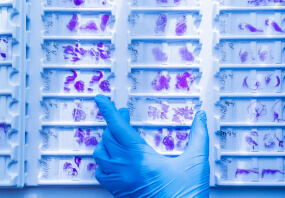General description
We are committed to bringing you Greener Alternative Products, which adhere to one of the four categories of Greener Alternatives . This product belongs to category of Re-engineered products, showing key improvements in Green Chemistry Principles “Designing Safer Chemicals”, "Safer Solvents and Auxiliaries" and “Reduce Derivatives”. Click here to view its DOZN scorecard.
Application
Poly-
- as a component of polyplexes and in DNA condensation experiments
- for coating circular mica disks for atomic force microscopy studies and SuperFrost glass slides for immunofluorescence studies of in HL-60 cells
- as a reference standard for generating calibration curve for the quantification of ε- Poly-
L -lysine
Biochem/physiol Actions
Poly-L-lysine is a nonspecific attachment factor for cells useful in promoting cell adhesion to solid substrates by enhancing electrostatic interaction between negatively charged ions of the cell membrane and the culture surface. When it is absorbed to the cell culture surface, poly-L-lysine functions to increase the number of positively charged sites available for cell binding. With cells that can digest poly-L-lysine, poly-D-lysine should be used as the attachment factor.
Components
Poly-L-lysine is a positively charged amino acid polymer with approximately one HBr per lysine residue. The hydrobromide allows the poly-L-lysine to be in a crystalline form soluble in water. A small amount of product may be found in the beta structure because the HBr interferes with hydrogen bonding between amino and either the carboxyl groups or N or O containing moieties.
Caution
Sterile solutions are stable for up to 2 years when stored at 2-8°C. It should be stored desiccated at -20°C.
Preparation Note
This product has a molecular weight of 4,000-15,000. To remove the HBr, dissolve this product in a neutral buffer and dialyze to remove the salts. None of the poly-L-lysine products have been exposed to trifluoroacetic acid and are dialyzed to remove any monomers, dimmers, or trimers, confirmed by thin layer chromatography. In general, to use this product as an attachment factor, add 50 mL of sterile tissue culture grade water to 5 mg of poly-lysine, and aseptically coat the surface with 1 mL per 25 cm2 of solution. After 5 minutes, remove the solution through aspiration and thoroughly rinse the surface. Let dry for two hours before introducing cells and medium.
- UPC:
- 41105803
- Condition:
- New
- Availability:
- 3-5 Days
- Weight:
- 1.00 Ounces
- HazmatClass:
- No
- MPN:
- P6516-1G
- CAS:
- 25988-63-0












